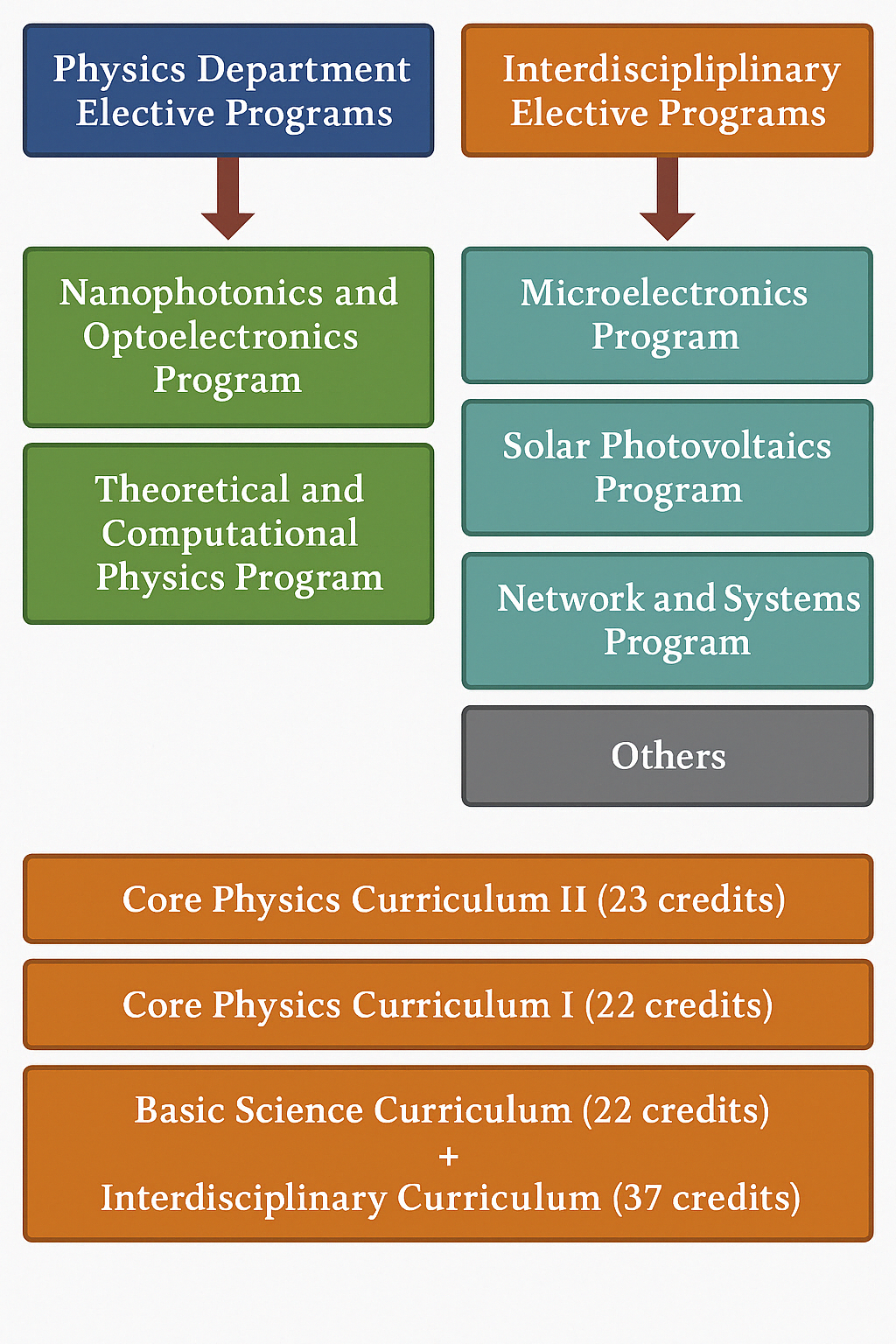學程簡介 Course Introduction
本系三學程簡介
物理學系專業學程領域說明:
《奈米與光電物理學程》
奈米與表面物理:學程領域包含奈米粒子操控、金屬單晶表面吸附原子與分子研究,奈米科技與生物系統結合、奈米材料醫學應用、可見光激發奈米光觸媒研究…等,直接探討奈米科技中最直接的問題,由於材料系統愈來愈小,位於表面的原子比例越來越高,因此表面的性質更為重要;尤其是位於表面的缺陷,對於奈米粒子的物理、化學性質影響甚大,是目前重要的研究課題之一。
《理論與計算物理學程》
理論物理:學程領域包括核子物理,粒子物理,天體物理與宇宙論,及多體理論(後者與計算物理研究群的課題密切相關),主旨在探討自然界基本作用力的性質,宇宙的結構與演化,以及多體系統在微觀與巨觀尺度中的圖像。理論物理的研究是利用數學與邏輯的語言來探討自然界中潛在的物理法則,並透過理論或模型的建構去解釋,乃至預測自然界中的諸般現象。故本學程的重點在於基本物理觀念的闡釋與相關數學工具的熟習,目的在培養學生對自然世界的理解與思維能力。
計算物理:學程領域包括第一原理計算、相變與臨界現象、計算生物物理及非平衡態統計力學之研究。計算科學是二十世紀下半葉興起的新學科。隨著電腦運算速度的提升,以電腦計算物質的各種性質已成為可能,因此近年來,計算物理已逐漸成為與實驗物理和理論物理三足鼎立的物理研究領域。未來計算物理的研究方向,是大型的模型建立與模擬計算,結合可用的設備,如多處理器或多平台系統,形成巨大的計算資源,並利用平行和分散式演算法,解決大型的科學計算問題。計算物理方法可廣泛應用於科學與工程的不同領域,如:生物科學、化學、經濟學、材料科學、機械、太空工程及電機工程等。
生物物理:生物物理學是一門跨領域的學科,是建立在物理、化學、生物及數學的方法上,來探討生物體系的學問,研究的對象小到分子尺度,大的話可含括全部的生物體系,例如以微觀的角度探討的體系,含括有機薄膜物理、蛋白質摺疊、分子和細胞生物物理、分子生物自由基連鎖反應、細胞內DNA及RNA的交互作用與蛋白質合成的關聯性,神經網路等問題。二十一世紀的生命科學、能源科技與資訊電子,將是對人類影響最深遠的科學,它們不但牽動整個學術界的變革,對人類社會也會產生巨大的衝擊,深遠影響人文思潮。近來,蛋白質體學與基因體學的蓬勃發展,更為人們對新的藥物發展,帶來新的曙光。物理學在微觀(如單分子檢測,X-ray結構學,中子散射結構學,質譜分析,核磁共振分析等)及巨觀之偵測技術發展上,有完備的學理基礎與模型,可以運用於生物分子體系的探索,得到嶄新的研究成果,並能得到突破性的發展,除了在學術上的研究突破外,以此為基礎,亦能開發新的生物技術,提升本國生物技術之層次,奠立生命科學之基礎。在二十一世紀,生命科學已成為一個重要領域,以物理學為基礎來探測未知的生命科學,更具有其獨特發展性。
凝體及材料物理:本學程訓練以凝體物理、材料科學課程為基礎,並提供光電應用相關之銜接課程。凝體與材料科學包含半導體、超導體物理、奈米技術、表面和低維度量子系統、磁性材料、功能性合金、表面和非線性複雜系統等研究領域,已成為二十一世紀科技發展重要的一環,許多新技術的應用,有賴於凝體科學的突破。凝體科學,在近代物理學的發展中,由於兼及理論和應用,而且橫跨工程與科學,具有跨領域的整合性,在高科技的產業中,扮演關鍵的地位。凝體科技同時也是本土重要產業中光電、電子(半導體)、通訊、資訊、航太和機械等高科技產業的基礎。

Introduction to the Three Academic Programs of the Department
Description of the Specialized Programs in the Department of Physics:
Nanoscience and Optoelectronics Physics Program
Nanoscience and Surface Physics: This program focuses on the manipulation of nanoparticles, studies of adsorbed atoms and molecules on metal single crystal surfaces, integration of nanotechnology with biological systems, biomedical applications of nanomaterials, and visible-light-activated nanophotocatalysts. These topics directly address core issues in nanotechnology. As material systems become smaller, the proportion of surface atoms increases, making surface properties more critical. Particularly, surface defects significantly affect the physical and chemical properties of nanoparticles, making them a key focus in current research.
Theoretical and Computational Physics Program
Theoretical Physics: This area covers nuclear physics, particle physics, astrophysics and cosmology, and many-body theory (closely related to computational physics). The aim is to explore the fundamental forces of nature, the structure and evolution of the universe, and representations of many-body systems on microscopic and macroscopic scales. Research in theoretical physics utilizes mathematics and logic to uncover physical laws and develop models to explain or predict phenomena in nature. The program emphasizes fundamental physical concepts and the mastery of mathematical tools, aiming to cultivate students' understanding and analytical thinking about the natural world.
Computational Physics: This field includes first-principles calculations, phase transitions and critical phenomena, computational biophysics, and non-equilibrium statistical mechanics. Computational science emerged in the latter half of the 20th century as a new discipline. With increasing computing power, it has become feasible to calculate material properties using simulations. As a result, computational physics now stands alongside theoretical and experimental physics as a core area of research. The future of computational physics lies in large-scale modeling and simulation, using resources like multi-processor or multi-platform systems, and solving complex scientific problems through parallel and distributed algorithms. Its methods are widely applicable across various fields such as biosciences, chemistry, economics, materials science, mechanical, aerospace, and electrical engineering.
Biophysics: Biophysics is an interdisciplinary field that applies the principles and methods of physics, chemistry, biology, and mathematics to study biological systems. Research topics range from molecular-scale investigations to whole biological systems. Examples include organic thin film physics, protein folding, molecular and cellular biophysics, free radical chain reactions in molecular biology, interactions of DNA and RNA within cells, protein synthesis mechanisms, and neural networks. In the 21st century, life sciences, energy technology, and information electronics are expected to profoundly impact humanity and academia. The rise of proteomics and genomics has also opened new possibilities for drug development. Physics provides strong theoretical models and techniques at both microscopic (e.g., single-molecule detection, X-ray crystallography, neutron scattering, mass spectrometry, NMR analysis) and macroscopic levels, contributing to breakthroughs in life science research and innovations in biotechnology. These developments will not only advance academic research but also enhance the national level of biotechnology and lay the foundation for life sciences.
Condensed Matter and Materials Physics Program
This program provides training based on condensed matter physics and materials science, along with supplementary courses related to optoelectronic applications. Areas of study include semiconductors, superconductors, nanotechnology, surface and low-dimensional quantum systems, magnetic materials, functional alloys, surface and nonlinear complex systems. These fields are critical to 21st-century technological development, as many emerging technologies rely on breakthroughs in condensed matter science. Bridging theory and application, condensed matter science integrates engineering and fundamental science and plays a pivotal role in high-tech industries. It underpins major domestic industries in optoelectronics, electronics (semiconductors), communications, information technology, aerospace, and mechanical engineering.

